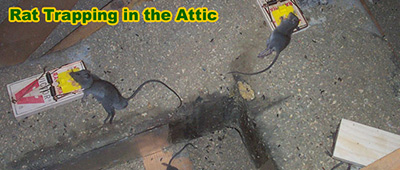As you can see, I sometimes trap rats on the roof. In fact, the most common name for the species rattus rattus is the Roof Rat.
They are named this because they spend 90% of their lives up off the ground - in trees, on power lines, and more often than not, because
rats live in urban environments with people, they are on the roof.

But they don't just hang out on the roof, of course. They are on the roof because they are going into the roof, and into the attic of houses and buildings. In fact, I think that rattus rattus should actually be called the Attic Rat! Regardless, because they so frequently use roof entry points, I sometimes set traps on the roof, as seen in the above photograph. Rats travel the same paths over and over, so I set the roof traps near an entry hole into the attic, and that catches them for sure!
HOW TO SET TRAPS ON THE ROOF
First of all, be careful. You're going to be doing some ladder work and climbing. I bolt the traps down using metal screws. When you do this, be
cognizant of breaching the roof of the house - you don't want leaks! I seal up any holes I create for trapping. The truth is that you don't actually
have to trap on the roof, as shown in the above photo. I prefer to trap inside the attic. There's no need to set trap on the roof - once the
rats are sealed out, why bother? I only did so to prove a point, that rats run on the roof to enter the holes into the attic. The fact that I caught
them, easily, proves that they run on the roof.

Rats don't really cause any problems on the roof proper. They don't destroy shingles. They poop and pee on the roof, yes, and you can see the evidence under UV light, but this is outside, and doesn't cause any harm that I know of.
Where are rats getting into my roof
Even though rats can enter a home at ground level, there are a few species that are adept climbers and will use trees or poles to gain access to a rooftop. The roof of a home is one of the most neglected areas of the structure. Roofs are out of immediate eyesight and any damage may go unnoticed for years. The most common areas for rats to sneak into a roof are at the vent openings and through damaged eaves. Both of these locations will provide instant access to the attic or roof area and a homeowner will only know there is damage if they are actively looking for it. Some homes have gaps around the chimney where rats can slip through. Chimneys have the roof built around them and will have gaps that are usually closed with roof tiles, tar, and skirting sealants. Over time, weather and age will break down these areas and result in gaps. Some rats will even go down the inside of inactive stone chimneys, so make sure caps are placed on all potential entry points in the roof, inactive or not. Keeping your trees cut back won't necessarily fix your problem, either. Rats that climb trees can scale the side of a home, too. Eliminating the tree will not eliminate the rat's desire to climb.
THE SAME APPLIES TO MICE ON THE ROOF
Although I wrote this site with rats in mind, such as the Roof Rat and Norway Rat, the same principles apply to other rodents, such as the house mouse. Mice
behave very similarly to rats, they're just smaller. Email me if you have any questions about how to trap a mouse on the roof, mice on the roof, and problems
with rodents on the roof.

What to do about a rat on the roof
If you have a rat on the roof, there's a good chance that rat has already been in your house. If it hasn't already, it's trying to get in. That means it will be trying to locate a piece of damage on the exterior of your home that it can sense airflow through, with the main intentions of tearing it open further so that it can get inside. If it's gone looking for damage to work on, it will find it. That is unless you're one step ahead of the rat, and you've already performed an inspection around your home, identifying damage and weak spots, and repaired them, or made them stronger using super-strong and durable materials that the rats won't be able to chew and gnaw through. These include steel and wire mesh, aluminum flashing, and also polyurethane sealant. It's the latter that will stop the airflow. If the rat can't sense the airflow, it won't bother trying to break it open.
Once you're done with that, it's then time to do the ACTUAL cleanup operation, and this will mean using strong biological enzyme cleaners that will eradicate all signs of the animal, alongside any disease threats it may have left behind, and pheromones in the urine.
What you shouldn't do it you come across or spot a rat on the roof is ignore it, or rely on repellents and deterrents to do the job for you. These very rarely work. In fact, they usually do the opposite – forcing the animal further into the depths of your home, and this is where they will die, set up home, pooping and peeing all over the place and attracting other animals, more rats included, and maybe (probably) have babies. Rats reproduce all year round, and they will do so at a staggering rate too. It's not long before one rat becomes a few hundred rats. That's not the kind of problem you will want to have on your hands.
If you don't fancy the responsibility of trying to get rid of a rat (or rats) from your property, either residential or commercial, get in touch. We've got the right tools and knowledge for this job, and those are two things that the average homeowner is generally missing. Plus, that's our job – that's what we're here for. (We do offer free advice, however, just in case all you need is a little guidance.)
Go back to the Rats in the Attic home page.
Having a rat on the roof is a dreaded nightmare for every homeowner because although rats are very small animals, they are very destructive once they get into your space. Rats contaminate food, spread disease, and are a general nuisance in every house they get into.
WHAT ATTRACTS RATS TO YOUR HOUSE
You may say you do not want rats in your house, but you must know what attracts them to your home and learn to keep those things far away. Rats love your roof and house when there is:
- POOR SANITATION: Rats are present in places where they have easy access to food and water sources. You should always keep your roof area clean because any garbage littered around your house attracts rats, and once these rats get into the house, they can get onto the roof.
- COMFORT: Rats need a comfortable and warm space to nest and raise their young ones. The tiny holes in your roof give them access, and your roof is cozy enough for them to make their home.
- AVAILABLE FOOD: The rats on your roof will eat anything available. They are not picky eaters, and so you must package and store food properly and keep your cooking area clean.
Rats are most active at night and take the day to sleep off the stress of the previous night’s activity and so most homeowners do not see the rats but see the evidence of their activities. You know that a rat is in your home when you see their droppings, which are capsule-shaped with blunt ends and a typical shining black color. You are also likely to see tracks and paths that will identify their movement patterns, gnaw holes that they make on wood, or damage to food packaging and electrical wiring.
How to get rid of rats on the roof
The best way to get rid of rats is to follow a three-layered approach:
SANITATION: This is the most important step and best way to keep roof rats away. Rats come into your home because of the comfort it offers. So to reduce or totally get rid of the rats on your roof, you should do the following:
- Remove clutter like cardboard or paper that the rats can use to build their nests.
- Store food properly in metal or lidded plastic containers and make sure you dispose of remaining food properly.
- Keep your house clean and clean out your roof often.
EXCLUSION: Rats enter structures through the small openings like air vents and screens and also through open doors and windows and so you can reduce their ease of entry by doing some of these:
- Seal any opening that is larger than half an inch with mesh, wood, or any appropriate material.
- Replace the flood drains in your home that has large drains.
- You should use flood sweeps where necessary and make sure all doors and window screens fit properly.
POPULATION REDUCTION: Rats are dangerous and carry many diseases that they can transmit to you and your pets. You can get rid of them by baiting and trapping the rats and relocating them or handing them over to the pest exterminator for disposal.
With these three steps, you can effectively reduce the population of rats on your roof and around your home.








